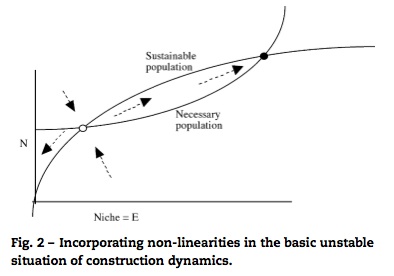
New about niche conceptions
September 6, 2008Recently i have been intrigued by the niche conception and its application in the ecological learning framework common in Web 2.0 communities. Here are some papers of interest.
——————————————————————-
Macroevolution of ecosystem engineering, niche construction and diversity
Douglas H. Erwin
Trends in Ecology and Evolution Vol.23 No.6
2008
Diversity begets diversity.
Douglas (2008) has assumed that in the macroevolutional perspective that reaches beyond species level, the niche construction, done by organisms as the feedback to their environment, and ecosystem engineering, where organisms influence the ecological success of other species, has increased over time, influencing the increase of biodiversity.
Ecosystem engineering can have positive impact on diversity by constructing habitats that can be occupied by other species, usually through increasing structural heterogeneity and patchiness and by direct impacts on resource availability.
Romer’s (1990) crucial insight was to realize that economic growth ultimately depends on the generation of non-rivalrous, non-excludable goods because these goods produce economic spillover effects (positive feedback) that percolate across the economy. These goods have a greater impact on growth than other types of innovation.
This economic insight indicates that the greatest impact of niche construction and ecosystem engineering is when they produce innovations that are analogous to non-rivalrous, non-excludable goods with long persistence (Douglas, 2008).
Author arises a number of interesting guestions that need to be answered:
How have these processes of niche generation and ecosystem engineering influenced community assembly and -recovery from mass extinctions?
Have niche generation and ecosystem engineering had a significant role in evolutionary innovations?
Are ecosystem engineers more resistant to extinction?
Has the absence of ecological inheritance inhibited recovery after biotic crises?
———————————————————–
The niche construction paradigm in ecological time
John Vandermeer
e c o l o g i c a l m o d e l l i n g, 2 1 4 ( 2 0 0 8 ) 385–390
Niche construction: The organism has a profound effect on the very environment that generates the selective pressure to which the population of the organism responds with genetic change, thus effecting evolution.
The equilibrium theory states that there is a balance between the need for a certain population to maintain the constructed niche and the size of the population that can be sustained by that niche.
The necessary population is the number of individuals necessary to maintain a particular constructed niche.
The niche affects the organism and effectively dictates how many individuals can be sustained at a given level of constructed niche. This is the sustainable population.
The relationship between the necessary and sustainable populations defines a clear dynamic for the population and its niche.
A critical population density is necessary (along with a critical niche) for the population to be successful.
In a facultative constructive niche the organism survives even in the absence of niche construction, nevertheless benefits further from the construction.
In an obligate constructive niche the organism dies in the absence of construction.
Similarly, a facultative organism survives even in a non-constructive niche, but benefits further from the construction, whereas an obligate organism does not survive unless a constructed niche becomes available.
There also exists an evident case of niche construction that cannot really be included in the present formulation, that in which an individual manufactures some aspect of its own niche that has relatively no effect on other individuals of the population. Nests, burrows and webs, for example, are clearly examples of constructed environments, but they do not translate into population-level density dependent effects and are more akin to other individual traits such as skin color, toxicity or flight ability.
Furthermore, while niches are constructed by organisms, they are also destructed by organisms.
—————————————————————————-
Revisiting Interpersonal Media Competition
The Gratification Niches of Instant Messaging, E-Mail, and the Telephone
Artemio Ramirez Jr.
John Dimmick
John Feaster
Shu-Fang Lin
Communication Research
Volume 35 Number 4
August 2008 529-547
At its most general, the theory of niche explains how media compete and coexist in limited resource environments (Dimmick, 2003).
Niche is the position of a medium in the multidimensional resource space of the environment.
The niche of a medium is derived from its pattern of resource use, represents its strategy for survival and growth, and ultimately determines its position in a multidimensional resource space.
Gratification opportunities are properties of a medium that allow users to overcome time and space constraints and, in effect, amplify or attenuate the ability to derive satisfaction from a medium.
The gratification niche of a medium is defined within a domain of gratification and gratification opportunity measures common to a set of media.
The gratification niche of a medium can be defined by its breadth on the gratification and gratification opportunities dimensions, the degree of overlap with other media, and its superiority in satisfying needs over other media within the same domain.
Three characteristics are central to understanding a medium’s niche:
1. Niche breadth, or the degree to which a medium satisfies a relatively broad or relatively narrow spectrum of media-related needs. Niche breadth can be interpreted as relative specialism or relative generalism. Specialists gratify a relatively narrow set of needs, and generalists satisfy a broader spectrum.
2. Niche overlap, or the extent to which media are perceived as similar, indicated by the distance between their gratification niches. Put differently, niche overlap is an index of the substitutability or complementarity of two media. High overlap indicates that media are substitutes or serve the same needs, whereas lower overlap indicates that different needs are being served. Thus, low overlap points toward the complementarity of the media, whereas high overlap indicates strong similarity or competition.
3. Competitive superiority, or the extent to which one or the other of a pair of media provide greater gratification. Indices of superiority for gratification measures are defined as arithmetic means, and differences between two means on a dimension can be tested for significance using a t test for correlated groups.
The complete replacement of one medium by another is termed competitive exclusion, and partial replacement is termed competitive displacement.
The mathematical measures of niche breadth, overlap, and superiority were developed by Dimmick (1993; see Dimmick, 2003, for computational formulas) as interval equivalents of the bioecological measures that are appropriate for nominal scales.
Dimmick,J. (2003). Media competition and coexistence:The theory of the niche. Mahwah, NJ:Lawrence Erlbaum.

—————————————————————————————
A general framework for the statistical exploration of the ecological niche
Clement Calenge
Mathieu Basille
Journal of Theoretical Biology 252 (2008) 674– 685
The graphical exploration of the relationships between a species and its environment may rely on the formal concept of ecological niche (Hutchinson, 1957). Each environmental variable can define a dimension of a multidimensional space, namely the ecological space. In that space, the distribution of the species occurrences represents the niche, which can be compared to the environment defined as available to the species (e.g., pixels of a raster map). This concept allows both a graphical and a quantitative exploratory analysis, in order to identify the directions in the ecological space where the distribution of the species is most different from the distribution of points describing the environment available to the species.
However, the present ‘lack of effective tools for exploring, analysing, and visualizing ecological niches in many-dimensional environmental space’ (Soberon and Peterson, 2005) may render this task difficult. The Ecological-niche factor analysis (ENFA, Hirzel et al., 2002) and the Mahalanobis distances factor analysis (MADIFA, Calenge et al., 2008) are two such methods.
———————————————————————-
The neuroscience of primate intellectual evolution: natural selection and passive and intentional niche construction
Atsushi Iriki, and Osamu Sakura
Phil. Trans. R. Soc. B (2008) 363, 2229–2241
Iriki and Sakurai (2008) propose a theory of intentional niche construction as an extension of natural selection in order to reveal the evolutionary mechanisms that forged the uniquely intelligent human brain.
Tool use sets up mutual interaction between the organisms and their environments. Tools become embedded cultural traces that are used to modify the environment in which subsequent generations develop and learn. This constructed environment puts selection pressure on the species, favouring individuals with phenotypes (whether morphological features or neural circuitry) that match the usages of such traces.
People have long commented that as one becomes deft with a tool, introspectively it begins to feel as though the tool has been incorporated into one’s body image as an extended hand or forearm.
We were studying intraparietal bimodal neurons that respond both to tactile stimulation on the hand (a neuron’s tactile receptive field) and to visual stimuli presented in the same spatial vicinity as the tactile receptive field (the same neuron’s visual receptive field). These visual receptive fields were not confined to any region of the retina, but followed the hand around everywhere it was moved in the three-dimensional space.
We interpreted these neuronal response proper ties as coding the image of the hand in space ( Iriki et al. 1996; Maravita & Iriki 2004). Our next observation was surprising. When our rake-trained monkeys wielded the rake in order to retrieve food, these same neurons’ visual receptive fields extended outwards along the axis of the tool (ac) to include the rake’s head. In other words, it appeared that either the rake was being assimilated into the image of the hand or, alternatively, the image of the hand was extending to incorporate the tool.
Whenever a monkey was not regarding the rake as a tool and just held it passively as an external object (ad), the visual receptive field withdrew from the rake head and was again limited to the space around the hand.
If external objects can be reconceived as belonging to the body, it may be inevitable that the converse reconceptualization, i.e. the subject can now objectify its body parts as equivalent to external tools, becomes likewise apparent.
Thus, tool use may lead to the ability to disembody the sense of self from the literal flesh-and-blood boundaries of one’s skin.
It has been repeatedly emphasized that since changes in behaviour precede morphological changes, behaviour must be viewed as one of the prime ‘engines’ of the evolutionary process (see ar ticles in Plotokin (1988) for review), rather than simply the end product of it. Apart from some classical philosophical arguments, this kind of argument originated with Darwin (1881) himself, and has been recently re-evaluated as the ‘niche construction theory’ (Odling-Smee et al. 2003).
In all non-human species, the process of organism–environment interaction proceeds through a finite number of cycles, which eventually reaches an equilibrium point and then stops. Such interaction is purely passive, a ratchet process prefigured by the combined characteristics of the subject and the environment to which it must adapt. Thus, we can call this process passive niche construction.
When organisms become aware of ‘subjective self ’, gained ability to explicitly imitate (Iriki 2006) or intentionally plan for the future, an additional factor was added on top of a pre-existing stable mode of environment, a novel mode of evolutionary circulation was initiated by succession of sequential niche construction processes.
Taking into consideration the similarities, equivalences and differences between enhanced monkey and modern human intellectual brain functions, we proposed a novel evolutionary mechanism, intentional niche construction, which we think is necessary, in addition to the mechanisms of Darwinian natural selection and passive niche construction, conceptually proposed by Darwin (1881) and later formalized by Odling-Smee et al. (2003), to account for the full course of human intellectual evolution.
Once goal-directed intentional niche construction was introduced into the evolutionary process, biological and cultural processes became intertwined to an unprecedented degree.
Humanity faces the unprecedented situation in which numerous minds possess external thinking devices linked simultaneously via the Internet. In such a situation, might the will of individual ‘subjects’ become separate from their bodies and act mutually, through the interdependent functioning of the Internet, with the shards of a thousand selves forming the community of an imaginary society? In such an event, perhaps the advanced, virtual concept of ‘multi-selves’ will emerge, evolving through the neuro-biological mechanisms depicted here as they carry us into the future.
————————————————————-
Return of the niche
Mathew A. Leibold
NATURE Vol 454, 3 July 2008
Traditional explanations for the local co-existence of species hold that the balance of nature is delicately related to differences in how species interact with their local environments (their ‘niches’), with populations of each species being primarily regulated by distinct environmental factors. Such niche partitioning results in stable frequency dependence, in which each species increases relative to others when it is rare, and decreases when it is common.
This venerable view has been confronted with the contention, arising from recent modelling work, that stochastic demography and dispersal are more important, and that they allow the widespread coexistence of species with identical niches. This ‘neutral theory’ has provided possible explanations for the occurrence of highly diverse communities that challenge the traditional view.










[…] New about niche conceptions By kaipata Niche construction: The organism has a profound effect on the very environment that generates the selective pressure to which the population of the organism responds with genetic change, thus effecting evolution. … Taming the spaces – https://tihane.wordpress.com […]
very very very interesting post, reminds me of the conversation we had at Elevant in Tallin. Copypasting your bibliography 😀
This stuff is really over my head!!
I couln never have imagined that blogging research was being conducted and have intricate and involved it might be. Is this really supposed to produce good blogs and bloggers?